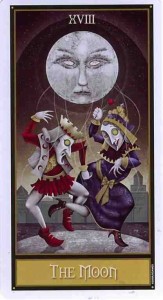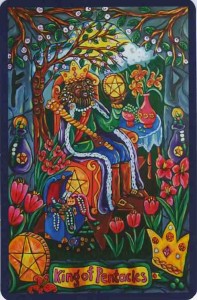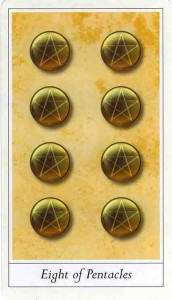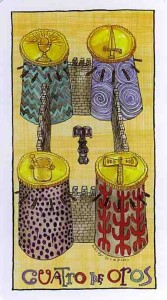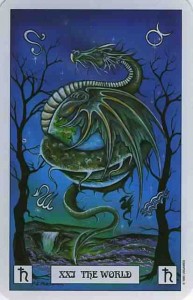[I love this little deck. It has no pretenses of grandiose history and no controversial past. There is no right or wrong about it.]
Illustrator: Ivy Hüttnerové
I told Martin, “Draw five cards to make a story. If you don’t like it, draw five more until you do.” This deck has a large portion of cards that can be interpreted somewhat (or entirely) negatively. After a number of random sequences, he settled on Lover-Trouble-Wedding-Journey-Love.
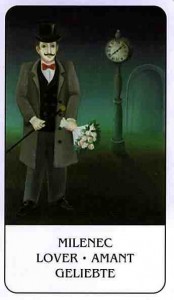 In the first image, a fine-dressed, mustaschioed man holds a bouquet in one hand, a gentleman’s cane in the other, and waits by a clock for his Lover. It is seven past eight in the evening. His nerves buzz with excitement. The woman he waits for is beautiful. Waiting for her, he feels like a child waiting for Christmas. She arrives, late.
In the first image, a fine-dressed, mustaschioed man holds a bouquet in one hand, a gentleman’s cane in the other, and waits by a clock for his Lover. It is seven past eight in the evening. His nerves buzz with excitement. The woman he waits for is beautiful. Waiting for her, he feels like a child waiting for Christmas. She arrives, late.
The second image follows soon after: Trouble. It is evening. A black cat fixes its yellow eyes upon us in a concentrated stare.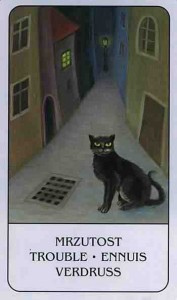 The path to his Lover’s heart is a labyrinth of convoluted passageways between close facades of the ancient city. Each house invites the man in with its illuminated windows, its warm, arched doorways. He does not know the many paths that take him to his Lover’s heart; he thinks there may be only one. But finding this path is not the only Trouble. Trouble is also what happens almost every time two hearts attempt to join. Two hearts meander alleyways, seek silhouettes across the glass, wonder at the scents of food and family life that seep from homes as people come and go. Windows— doors— open— close— each movement a brief glimpse into the secrets of the Lover’s heart. And then there is the day, that day they end up in the same room, dining at the same table, warmed by the same hearth. It is not the end to Trouble as one might suppose, but they have found each other’s hearts, and this alone makes wandering the strange dark streets of Trouble that much easier.
The path to his Lover’s heart is a labyrinth of convoluted passageways between close facades of the ancient city. Each house invites the man in with its illuminated windows, its warm, arched doorways. He does not know the many paths that take him to his Lover’s heart; he thinks there may be only one. But finding this path is not the only Trouble. Trouble is also what happens almost every time two hearts attempt to join. Two hearts meander alleyways, seek silhouettes across the glass, wonder at the scents of food and family life that seep from homes as people come and go. Windows— doors— open— close— each movement a brief glimpse into the secrets of the Lover’s heart. And then there is the day, that day they end up in the same room, dining at the same table, warmed by the same hearth. It is not the end to Trouble as one might suppose, but they have found each other’s hearts, and this alone makes wandering the strange dark streets of Trouble that much easier.
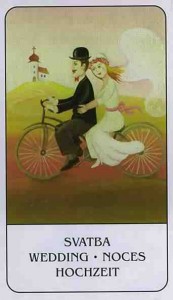 The third image shows a well-dressed couple together on a bicycle. The man wears a suit and bowler hat; the woman, a white, flowing dress, heels and a veil. Wedding. In the background is the church. Wedding itself is a simple thing: a moment in time: a ceremony: a declaration of intent towards future dedication. Wedding says: “These two hearts have met, now they are one.” Wedding shows pride in one’s Lover. Wedding is a ceremony for all to see. Here, there is no hiding of the heart.
The third image shows a well-dressed couple together on a bicycle. The man wears a suit and bowler hat; the woman, a white, flowing dress, heels and a veil. Wedding. In the background is the church. Wedding itself is a simple thing: a moment in time: a ceremony: a declaration of intent towards future dedication. Wedding says: “These two hearts have met, now they are one.” Wedding shows pride in one’s Lover. Wedding is a ceremony for all to see. Here, there is no hiding of the heart.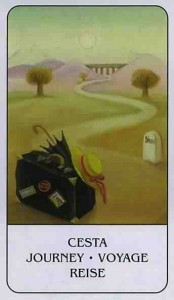
The fourth image shows a suitcase, umbrella, and a woman’s hat laid down by a path near a milestone. Journey. The path meanders past trees, through between high hills and under a bridge, off to the mountains of the horizon, off to the sun. There is no telling where the path goes unless one Journeys on it. There are two ways of traveling. One may look at one’s feet landing on the path and wonder where the path goes and when one may arrive. This makes the path a long one. Alternatively, one may look at each tree and hill as the final destination. This makes the Journey short and the destination always near, no matter how long the path winds on and on.
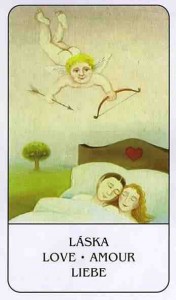 The fifth image is Love, both Lovers in bed, heads together and Cupid above ready to reload his bow with arrows. They are Lovers because they found each other in the Troubled pathways of the dark city, and they are Lovers because they Journey together towards the horizon of life’s winding path, admiring each tree and hill and milestone they pass, and they are Wed by life.
The fifth image is Love, both Lovers in bed, heads together and Cupid above ready to reload his bow with arrows. They are Lovers because they found each other in the Troubled pathways of the dark city, and they are Lovers because they Journey together towards the horizon of life’s winding path, admiring each tree and hill and milestone they pass, and they are Wed by life.
I am sorry this is such a boring story—
Martin wanted a happy ending.
I was ready to settle for House-Baby-Thief-Letter-Thoughts—
obviously a depressing, unsolved kidnapping mystery.




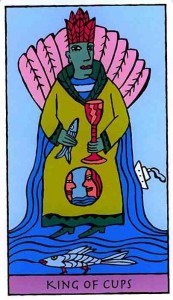
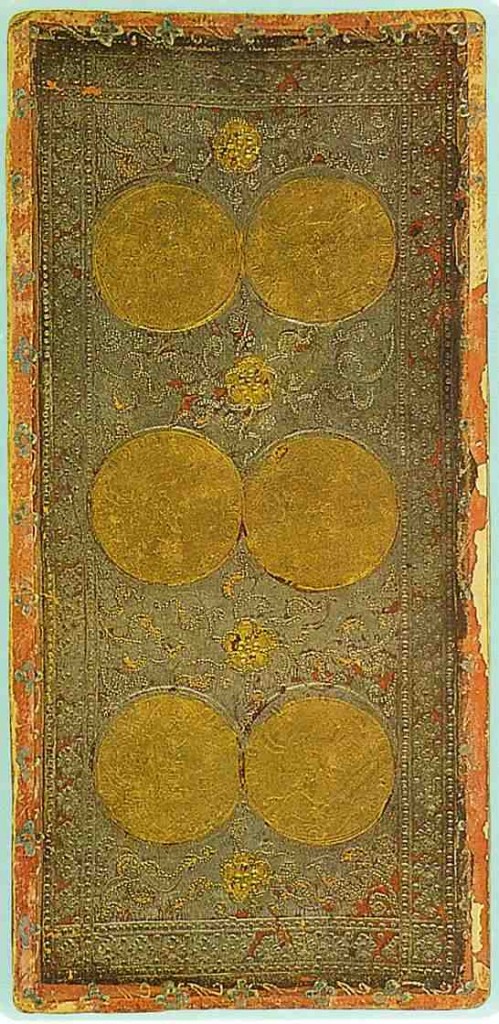
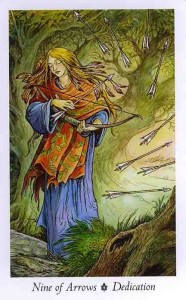
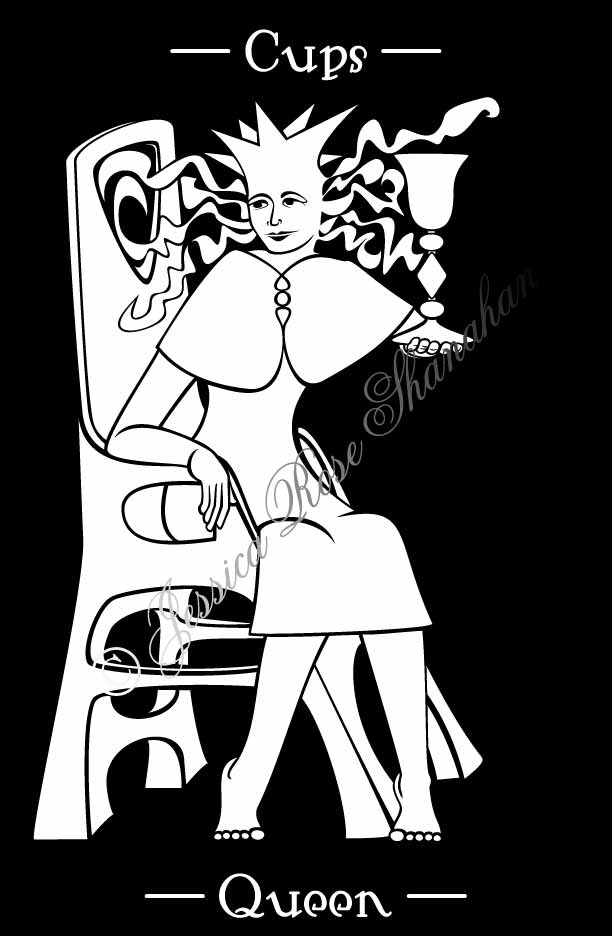 Artist: Jessica Rose Shanahan
Artist: Jessica Rose Shanahan